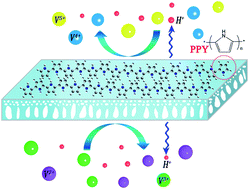Polypyrrole modified porous poly(ether sulfone) membranes with high performance for vanadium flow batteries†
Abstract
Polypyrrole (PPY) modified porous poly(ether sulfone) (PPY/PES) membranes with excellent ion conductivity and high ion selectivity are prepared and employed in vanadium flow batteries (VFBs). The porous PES membranes are modified through in situ polymerization of pyrrole (PR) by using VO2+ as the oxidizing agent. The positively charged PPY nanoparticles can effectively retain vanadium ions via the Donnan exclusion and afford excellent ion conductivity through the interaction between the sulfuric acid in electrolytes and the nitrogen elements in PPY. As a consequence, the designed PPY/PES porous membranes demonstrate high ion selectivity and excellent ion conductivity along with exceptional chemical stability under VFB operation conditions. The PPY/PES porous membranes exhibited a very prospective performance for vanadium flow applications, showing a coulombic efficiency (CE) of 96.30% and an energy efficiency (EE) of 87.20% at a current density of 80 mA cm−2, which are much better than those of a VFB with a Nafion 115 membrane (coulombic efficiency of 93.16% and energy efficiency of 82.29%). Furthermore, a VFB using the PPY/PES porous membranes delivers a stable battery efficiency after continuously operating for more than 100 cycles, displaying good potential usage in VFB applications.


 Please wait while we load your content...
Please wait while we load your content...